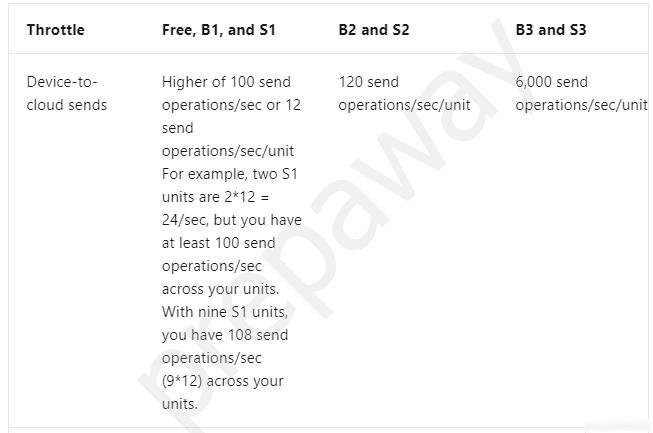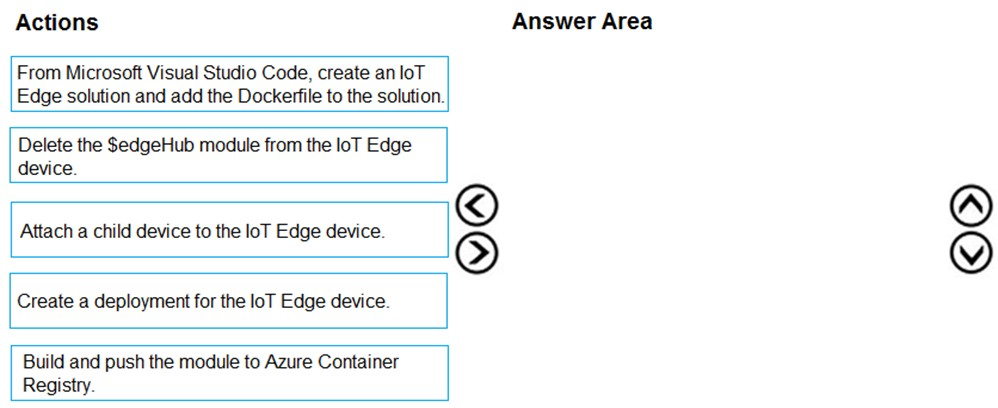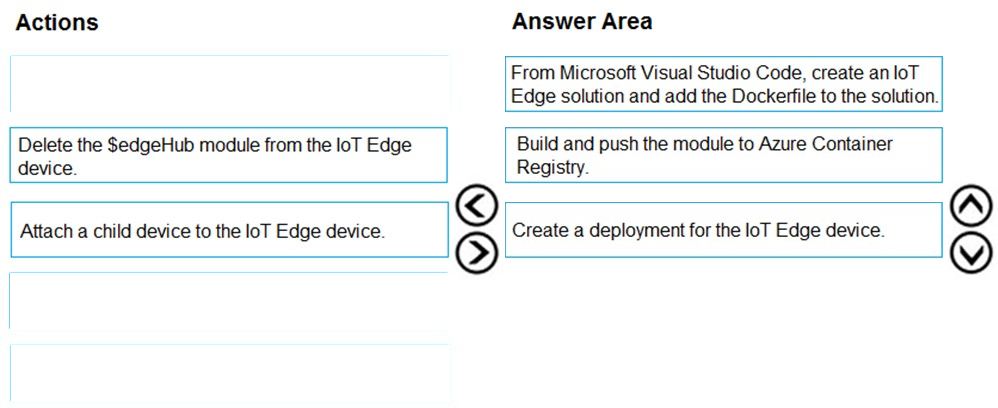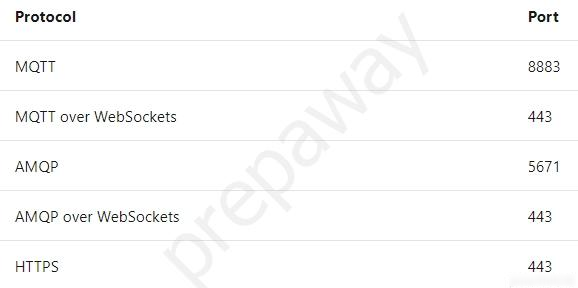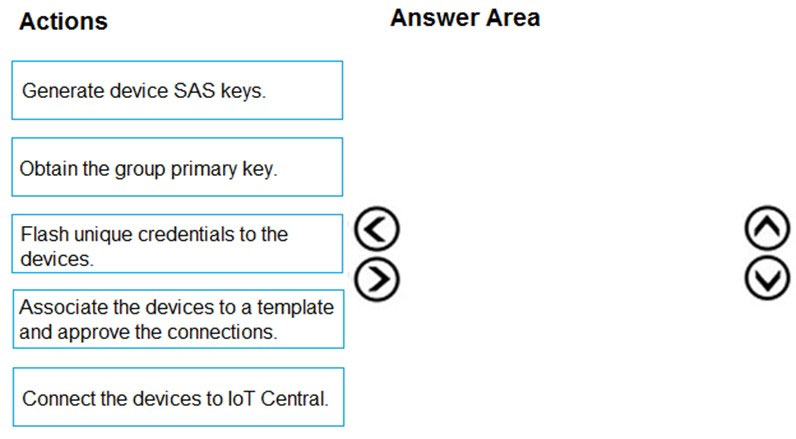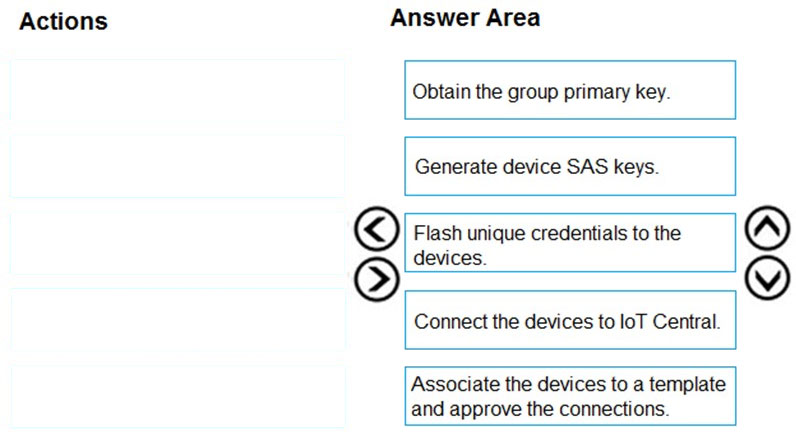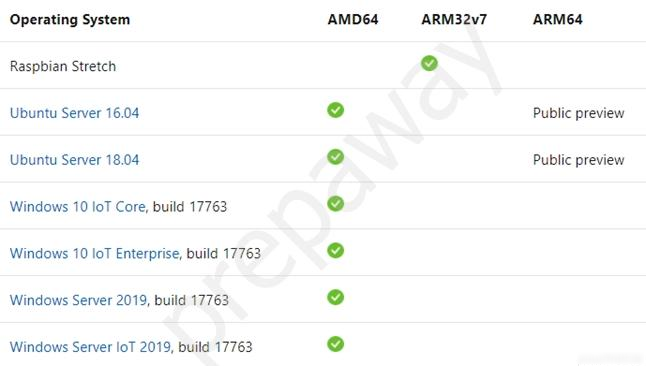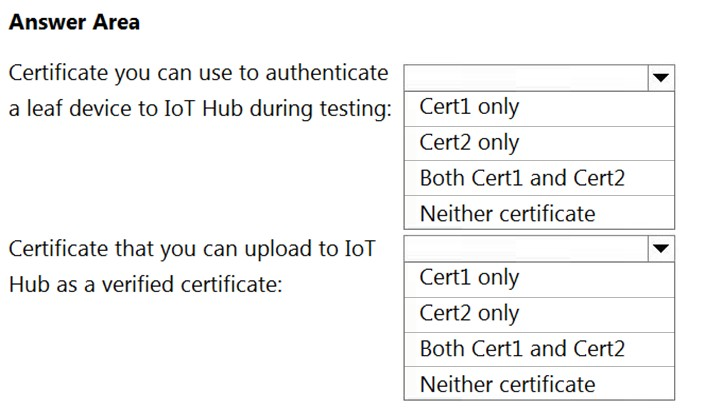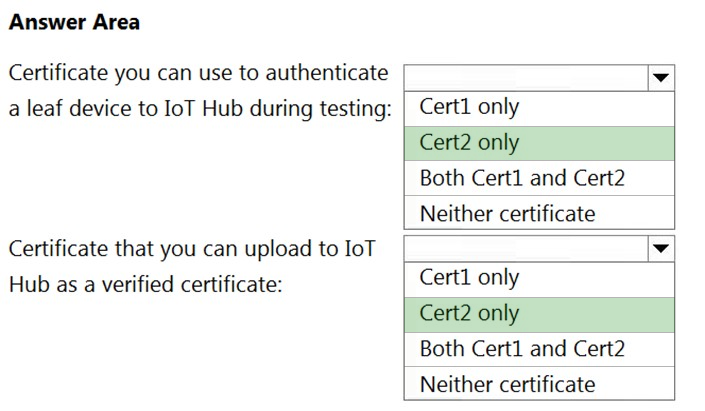AZ-220 Exam Prep Free – 50 Practice Questions to Get You Ready for Exam Day
Getting ready for the AZ-220 certification? Our AZ-220 Exam Prep Free resource includes 50 exam-style questions designed to help you practice effectively and feel confident on test day
Effective AZ-220 exam prep free is the key to success. With our free practice questions, you can:
- Get familiar with exam format and question style
- Identify which topics you’ve mastered—and which need more review
- Boost your confidence and reduce exam anxiety
Below, you will find 50 realistic AZ-220 Exam Prep Free questions that cover key exam topics. These questions are designed to reflect the structure and challenge level of the actual exam, making them perfect for your study routine.
You have 100 devices that connect to an Azure IoT hub. You plan to use Azure functions to process all the telemetry messages from the devices before storing the messages. You need to configure the functions binding for the IoT hub. Which two configuration details should you use to configure the binding? Each correct answer presents part of the solution. NOTE: Each correct selection is worth one point.
A. the name of the resource group that contains the IoT hub
B. the IoT hub’s connection string shared access key that has Service connect permissions
C. the connection string of the Azure Event Hub-compatible endpoint from the IoT Hub built-in endpoints
D. the Azure Event-Hub compatible name
HOTSPOT - You are creating an Azure Digital Twins query. You need to return all the digital twins that have a contains relationship with a digital twin that has an ID of twin1. How should you complete the query? To answer, select the appropriate options in the answer area. NOTE: Each correct selection is worth one point.
After you answer a question in this section, you will NOT be able to return to it. As a result, these questions will not appear in the review screen. You have an Azure IoT solution. You receive the following error in Azure Monitor "403006 DeviceMaximumActiveFileUploadLimitExceeded." You need to ensure that the file upload code is configured correctly. Solution: You limit the maximum concurrent file uploads to ten and notify an Azure IoT hub that a file upload has completed by using the REST API. Does this meet the goal?
A. Yes
B. No
You have an Azure IoT solution. You need to implement multi-factor device authentication by using custom device authentication. What should you do first?
A. Create an Azure Policy definition for Azure IoT Hub.
B. Enable multi-factor authentication (MFA) for Microsoft Azure Active Directory (Azure AD), part of Microsoft Entra.
C. Create a service endpoint policy.
D. Deploy a security token service.
You have an Azure IoT Edge module named SampleModule that runs on a device named Device1. You make changes to the code of SampleModule by using Microsoft Visual Studio Code. You need to push the code to the container registry and then deploy the module to Device1. Which two actions should you perform from Visual Studio Code? Each correct answer presents part of the solution. NOTE: Each correct selection is worth one point.
A. Build and push the SampleModule code to the registry.
B. Create a deployment for a single device.
C. Generate a deployment manifest.
D. Build an IoT Edge solution.
E. Generate a shared access signature (SAS) token for Device1.
You have ab Azure subscription that contains an Azure IoT hub named Hub1, 50 IoT devices, and an Azure Blob storage account named storage1. Hub1 will be used to route data from the IoT devices to storage1. You enable private endpoint access for Hub1. You need to ensure that Hub1 can route the data to storage1. What should you do?
A. On Hub1, create a shared access policy.
B. On Hub1, add an X.509 certificate.
C. Deploy an Azure IoT Edge gateway device.
D. On Hub1, configure a system-assigned managed identity.
You have 10 IoT devices that connect to an Azure IoT hub named Hub1. From Azure Cloud Shell, you run az iot hub monitor-events --hub-name Hub1 and receive the following error message: "az iot hub: 'monitor-events' is not in the 'az iot hub' command group. See 'az iot hub --help'." You need to ensure that you can run the command successfully. What should you run first?
A. az iot hub monitor-feedback –hub-name Hub1
B. az iot hub generate-sas-token –hub-name Hub1
C. az iot hub configuration list –hub-name Hub1
D. az extension add -name azure-cli-iot-ext
During the POV phase, you connect a device to IoT Hub and start sending telemetry messages. You need to verify the content of the messages received by IoT Hub during the POV phase. What should you use?
A. the Monitoring settings of IoT Hub or a Postman call to the IoT Hub REST API
B. Azure Monitor or Azure Log Analytics
C. Microsoft Visual Studio Code that uses the IoT Hub Toolkit or Azure CLI that uses the IoT Hub extension
D. Splunk or Grafana
After you answer a question in this section, you will NOT be able to return to it. As a result, these questions will not appear in the review screen. You have 10 devices that connect to an Azure IoT hub. Each device has a unique public IP address. The devices are not provisioned through DPS. You discover an anomaly in messages from two devices. You need to stop all messages from both devices without affecting the other devices. Solution: You delete the devices from the IoT hub. Does the solution meet the goal?
A. Yes
B. No
HOTSPOT - You have an Azure IoT Edge automatic deployment named D1 that deploys a temperature module to five IoT Edge devices. D1 has a deployment priority of 10 and the following module configuration.You need to create a new layered deployment that will add a new twin property named ReportingMode. The new deployment must not overwrite the existing module configurations set by D1. How should you configure the deployment? To answer, select the appropriate options in the answer area. NOTE: Each correct selection is worth one point.
You are configuring a production environment for an Azure IoT solution. You plan to deploy 1,000 IoT devices. Each device will send one device-to-cloud message every hour. Each message will be 4 KB. You need to deploy an Azure IoT hub that will support the IoT device deployment. The solution must meet the following requirements: ✑ Perform bulk device operations such as creating multiple device identities. ✑ Minimize costs What should you deploy?
A. one unit of the B1 tier
B. one unit of the free tier
C. one unit of the S1 tier
D. one unit of the S2 tier
DRAG DROP - Your company develops a custom module and exports the module as a Linux Dockerfile. You need to deploy the module to an Azure IoT Edge device that runs Ubuntu Server 18.04. Which three actions should you perform in sequence? To answer, move the appropriate actions from the list of actions to the answer area and arrange them in the correct order. Select and Place:
You have an Azure IoT solution that includes multiple Azure IoT hubs in different geographic locations and a single Device Provision Service instance. You need to configure device enrollment to assign devices to the appropriate IoT hub based on the following requirements: ✑ The registration ID of the device The geographic location of the deviceThe load between the IoT hubs in the same geographic location must be balanced. What should you use to assign the devices to the IoT hubs?
A. Static configuration (via enrollment list only)
B. Lowest latency
C. Evenly weighted distribution
D. Custom (Use Azure Function)
DRAG DROP - You have the following Azure Stream Analytics query.You need to build a Stream Analytics query that will use a JavaScript user-defined aggregate (UDA) function named UDA1 to sum the TemperatureDB values. How should you complete the function? To answer, drag the appropriate values to the correct targets. Each value may be used once, more than once, or not at all. You may need to drag the split bar between panes or scroll to view content. NOTE: Each correct selection is worth one point.
After you answer a question in this section, you will NOT be able to return to it. As a result, these questions will not appear in the review screen. You have an Azure Stream Analytics job that receives input from an Azure IoT hub and sends the outputs to Azure Blob storage. The job has compatibility level 1.1 and six streaming units. You have the following query for the job.You plan to increase the streaming unit count to 12. You need to optimize the job to take advantage of the additional streaming units and increase the throughput. Solution: You change the compatibility level of the job to 1.2. Does this meet the goal?
A. Yes
B. No
DRAG DROP - You have sites that contain IoT devices as shown in the following table.You have an Azure subscription. You need to create the Azure IoT Edge devices shown in the following table.
Which type of gateway pattern should you use for each IoT Edge device? To answer, drag the appropriate gateway pattern types to the correct devices. Each pattern type may be used once, more than once, or not at all. You may need to drag the split bar between panes or scroll to view content. NOTE: Each correct selection is worth one point.
DRAG DROP - You have an Azure IoT solution that includes an Azure IoT hub, a Device Provisioning Service instance, and 1,000 connected IoT devices. The IoT devices are allocated to four enrollment groups. Each enrollment group is configured to use certificate attestation. You need to decommission all the devices in a single enrollment group and the enrollment group itself. Which three actions should you perform in sequence? To answer, move the appropriate actions from the list of actions to the answer area and arrange them in the correct order. Select and Place:
You have an Azure IoT solution. You prepare a new Azure IoT Edge device for deployment to the solution. You need to ensure that the device is configured to meet Azure best practices. What should you do?
A. From the IoT Edge device, run the iotedge check command.
B. From the IoT Edge device, run the iotedge logs edgeAgent and iotedge logs edgeHub commands.
C. From Azure Cloud Shell, run the Get-AzSecurityCompliance cmdlet.
D. From Azure Cloud Shell, run the az iot edge deployment show command.
HOTSPOT - You have sites that contain industrial control devices as shown in the following table.You have an Azure subscription that contains an Azure IoT hub. The IoT hub has Microsoft Defender for IoT enabled. You plan to deploy Microsoft Defender for IoT to the devices. For each of the following statements, select Yes if the statement is true. Otherwise, select No. NOTE: Each correct selection is worth one point.
You have an Azure IoT Hub deployment. You plan to deploy 1,000 IoT devices that will have 1 MB of RAM. The devices will be deployed behind firewalls that block port 443. You need to configure the communication protocol for the devices. The solution must ensure that each device uses unique credentials. Which protocol should you use?
A. AMQP
B. MQTT over WebSockets
C. MQTT
D. AMQP over WebSockets
DRAG DROP - You have an Azure IoT hub. You need to deploy a Device Provisioning Service instance that uses X.509 attestation to support new IoT devices. Which three actions should you perform in sequence in the Azure portal? To answer, move the appropriate actions from the list of actions to the answer area and arrange them in the correct order.
You have a remote network that contains an IoT device named Device1 and a firewall named Firewall1. You have an Azure subscription that contains an Azure IoT hub named Hub1. Device1 is registered to Hub1. Firewall1 only allows outbound traffic from Hub1 via TCP port 443. You need to build an app that will connect to Device1 by using SSH on port 22. The solution must minimize costs. What should you configure to connect to Device1?
A. IoT Hub message routing
B. shared access policies
C. Azure Private Link
D. IoT Hub device streams
After you answer a question in this section, you will NOT be able to return to it. As a result, these questions will not appear in the review screen. You have an Azure IoT solution. You plan to register an Azure loT Edge device by using X.509 self-signed certificates. You need to provide the thumbprint for the primary and secondary certificates. Solution: You generate a 96-hex character SHA384 hash for the certificates. Does this meet the goal?
A. Yes
B. No
After you answer a question in this section, you will NOT be able to return to it. As a result, these questions will not appear in the review screen. You have 20 IoT devices deployed across two floors of a building. The devices on the first floor must be set to 60 degrees. The devices on the second floor must be set to 80 degrees. The device twins are configured to use a tag that identifies the floor on which the twins are located. You create the following automatic configuration for the devices on the first floor.You create the following automatic configuration for the devices on the second floor.
The IoT devices on the first floor report that the temperature is set to 80 degrees. You need to ensure that the first-floor devices are set to the correct temperature. Solution: In the automatic configuration for the first-floor devices, you set targetCondition to “tags.floor=‘second’”. Does this meet the goal?
A. Yes
B. No
You have an Azure IoT solution that includes a basic tier Azure IoT hub named Hub1 and a Raspberry Pi device named Device1. Device1 connects to Hub1. You back up Device1 and restore the backup to a new Raspberry Pi device. When you start the new Raspberry Pi device, you receive the following error message in the diagnostic logs of Hub1: "409002 LinkCreationConflict." You need to ensure that Device1 and the new Raspberry Pi device can run simultaneously without error. Which two actions should you perform? Each correct answer presents part of the solution. NOTE: Each correct selection is worth one point.
A. On the new Raspberry Pi device, modify the connection string.
B. From Hub1, modify the device shared access policy.
C. Upgrade Hub1 to the standard tier.
D. From Hub1, create a new consumer group.
E. From Hub1, create a new IoT device.
You have an Azure IoT Central solution that includes multiple IoT devices. The devices report temperature, humidity, and pressure. You need to export the sensor data captured during a 48-hour period as a CSV file. What should you use in IoT Central?
A. Devices
B. Jobs
C. Device groups
D. Analytics
You have an Azure IoT Edge device. You need to modify the credentials used to access the container registry. What should you modify?
A. the $edgeHub module twin
B. the IoT Edge module
C. the $edgeAgent module twin
D. the Azure IoT Hub device twin
You have an Azure IoT solution that includes an Azure IoT hub and 100 Azure IoT Edge devices. You plan to deploy the IoT Edge devices to external networks. The firewalls of the external networks only allow traffic on port 80 and port 443. You need to ensure that the devices can connect to the IoT hub. The solution must minimize costs. What should you do?
A. Configure the upstream protocol of the devices to use MQTT over TCP.
B. Configure the upstream protocol of the devices to use MQTT over WebSocket.
C. Connect the external networks to the IoT solution by using ExpressRoute.
D. Integrate cellular communication hardware onto the devices and avoid the use of the external networks.
HOTSPOT - You are planning a project that will use an Azure IoT hub. You have two authentication certificates named Cert1 and Cert2. Cert1 is a CA signed certificate and Cert 2 is a leaf certificate. You need to identify which certificates to use. What should you identify? To answer, select the appropriate options in the answer area. NOTE: Each correct selection is worth one point.
You are prototyping an IoT edge solution. You are creating a deployment manifest for an IoT edge device that will connect to an Azure IoT hub. Which two modules should you include in the manifest? Each correct answer presents part of the solution. NOTE: Each correct selection is worth one point.
A. azureiotsecurity
B. edgeHub
C. opc-publisher
D. edgeAgent
E. iotedgeModbus
DRAG DROP - You are building an IoT device management application by using the Azure IoT Hub Service SDK. You need to configure the application to send instructions via an IoT hub to IoT devices. How should you complete the code? To answer, drag the appropriate values to the correct targets. Each value may be used once, more than once, or not at all. You may need to drag the split bar between panes or scroll to view content. NOTE: Each correct selection is worth one point.
After you answer a question in this section, you will NOT be able to return to it. As a result, these questions will not appear in the review screen. You have an Azure IoT solution. You plan to register an Azure loT Edge device by using X.509 self-signed certificates. You need to provide the thumbprint for the primary and secondary certificates. Solution: You generate a 64-hex character SHA256 hash for the certificates. Does this meet the goal?
A. Yes
B. No
You have an Azure IoT solution that contains an Azure IoT hub. The IoT hub uses Microsoft Defender for IoT for device builders and an IoT device named ContosoDevice1. You need to implement the Defender for IoT micro agent. What should you configure in the IoT hub?
A. a module twin
B. a private endpoint
C. an Azure IoT Edge module
D. the device twin
After you answer a question in this section, you will NOT be able to return to it. As a result, these questions will not appear in the review screen. You have an Azure subscription that contains the resources shown in the following table.You create a group enrollment in DPS1 and enroll 100 IoT devices. Each device is issued a leaf certificate from CA1. You need to deprovision a single IoT device from the group enrollment. The solution must not affect the other devices. Solution: You create a disabled symmetric key individual enrollment by using the device ID of the device. Does this meet the goal?
A. Yes
B. No
HOTSPOT - You create an Azure IoT hub as shown in the following exhibit.For each of the following statements, select Yes if the statement is true. Otherwise, select No. NOTE: Each correct selection is worth one point.
You have an Azure IoT Central solution. You need to verify that telemetry messages from devices arrive to IoT Central. What should you use?
A. the Azure IoT explorer
B. the az command in Azure CLI
C. Azure Service Bus Explorer
D. the Azure IoT Tools for VS Code extension pack
You have an IoT device that gathers data in a CSV file named Sensors.csv. You deploy an Azure IoT hub that is accessible at ContosoHub.azure-devices.net. You need to ensure that Sensors.csv is uploaded to the IoT hub. Which two actions should you perform? Each correct answer presents part of the solution. NOTE: Each correct selection is worth one point.
A. Upload Sensors.csv by using the IoT Hub REST API.
B. From the Azure subscription, select the IoT hub, select Message routing, and then configure a route to storage.
C. From the Azure subscription, select the IoT hub, select File upload, and then configure a storage container.
D. Configure the device to use a GET request to ContosoHub.azure-devices.net/devices/ContosoDevice1/files/notifications.
HOTSPOT - You have an Azure IoT hub. You have four Azure IoT Edge devices and the device twin code shown in the following table.You have three deployments and the deployment code shown in the following table.
For each of the following statements, select Yes if the statement is true. Otherwise, select No. NOTE: Each correct selection is worth one point.
After you answer a question in this section, you will NOT be able to return to it. As a result, these questions will not appear in the review screen. You have an Azure IoT solution that includes an Azure IoT hub, a Device Provisioning Service instance, and 1,000 connected IoT devices. All the IoT devices are provisioned automatically by using one enrollment group. You need to temporarily disable the IoT devices from the connecting to the IoT hub. Solution: From the Device Provisioning Service, you disable the enrollment group, and you disable device entries in the identity registry of the IoT hub to which the IoT devices are provisioned. Does the solution meet the goal?
A. Yes
B. No
You have an Azure subscription named Sub1. You need to ensure that when a new Azure IoT hub is created in Sub1, a warning appears indicating that communication must be allowed only from known networks. The solution must minimize development and administrative effort. What should you include in the solution?
A. an application security group rule
B. an Azure function
C. an Azure policy
D. an Azure Monitor alert
DRAG DROP - You have an Azure IoT Central application. You need to connect IoT devices that use SAS tokens to the application without first registering the devices. In which order should you perform the actions? To answer, move all actions from the list of actions to the answer area and arrange them in the correct order. Select and Place:
DRAG DROP - You have an Azure IoT solution that includes an Azure IoT hub. You receive a root certification authority (CA) certificate from the security department at your company. You need to configure the IoT hub to use the root CA certificate. Which four actions should you perform in sequence? To answer, move the appropriate actions from the list of actions to the answer area and arrange them in the correct order. Select and Place:
You have an Azure IoT solution that includes an Azure IoT Hub named Hub1 and an Azure IoT Edge device named Edge1. Edge1 connects to Hub1. You need to deploy a temperature module to Edge1. What should you do?
A. From the Azure portal, navigate to Hub1 and select IoT Edge. Select Edge1, and then select Manage Child Devices. From a Bash prompt, run the following command: az iot edge set-modules –device-id Edge1 –hub-name Hub1 –content deploymentMan1.json
B. Create an IoT Edge deployment manifest that specifies the temperature module and the route to $upstream. From a Bash prompt, run the following command: az iot hub monitor-events –device-id Edge1 –hub-name Hub1
C. From the Azure portal, navigate to Hub1 and select IoT Edge. Select Edge1, select Device Twin, and then set the deployment manifest as a desired property. From a Bash prompt, run the following command: az iot hub monitor-events –device-id Edge1 –hub-name Hub1
D. Create an IoT Edge deployment manifest that specifies the temperature module and the route to $upstream. From a Bash prompt, run the following command: az iot edge set-modules –device-id Edge1 –hub-name Hub1 –content deploymentMan1.json
You have 1,000 devices that connect to an Azure IoT hub. You are performing a scheduled check of deployed IoT devices. You plan to run the following command from the Azure CLI prompt. az iot hub query --hub-name hub1 --query-command "SELECT * FROM devices WHERE connectionState = 'Disconnected'" What does the command return?
A. the Device Disconnected events
B. the device twins
C. the Connections logs
D. the device credentials
DRAG DROP - You have an Azure subscription that contains an Azure IoT Edge device named Edge1 and an Azure container registry named Registry1. You need to configure Edge1 to connect to Registry1. How should you complete the deployment manifest? To answer, drag the appropriate values to the correct targets. Each value may be used once, more than once, or not at all. You may need to drag the split bar between panes or scroll to view content. NOTE: Each correct selection is worth one point.
After you answer a question in this section, you will NOT be able to return to it. As a result, these questions will not appear in the review screen. You are developing a custom Azure IoT Edge module. The module needs to identify the device ID of the local device. Solution: You configure the module to read the IOTEDGE_DEVICEID environment variable. Does this meet the goal?
A. Yes
B. No
You are developing an Azure IoT Central application. You add a new custom device template to the application. You need to add a fixed location value to the device template. The value must be updated by the physical IoT device, read-only to device operators, and not graphed by IoT Central. What should you add to the device template?
A. a Location property
B. a Location telemetry
C. a Cloud property
You have the devices shown in the following table.You are implementing a proof of concept (POC) for an Azure IoT solution. You need to deploy an Azure IoT Edge device as part of the POC. On which two devices can you deploy IoT Edge? Each correct answer presents a complete solution. NOTE: Each correct selection is worth one point.
A. Device1
B. Device2
C. Device3
D. Device4
HOTSPOT - You are planning a proof of concept (POC) that will use an Azure IoT hub. You have two self-signed client authentication certificates named Cert1 and Cert2. Cert1 has a basic constraint that contains Subject Type=CA. Cert2 has a basic constraint that contains Subject Type=End Entity. You need to identify which certificates to use. What should you identify? To answer, select the appropriate options in the answer area. NOTE: Each correct selection is worth one point. Hot Area:
You have an Azure IoT solution that includes several Azure IoT hubs. A new alerting feature was recently added to the IoT devices. The feature uses a new device twin reported property named alertCondition. You need to send alerts to an Azure Service Bus queue named MessageAlerts. The alerts must include alertCondition and the name of the IoT hub. Which two actions should you perform? Each correct answer presents part of the solution. NOTE: Each correct selection is worth one point.
A. Configure File upload for each IoT hub. Configure the device to send a file to an Azure Storage container that contains the device name and status message.
B. Add the following message enrichments: Name = iotHubName Value = $twin.tag.location Endpoint = MessageAlerts
C. Create an IoT Hub routing rule that has a data source of Device Twin Change Events and select the endpoint for MessageAlerts.
D. Add the following message enrichments: Name = iotHubName Value = $iothubname Endpoint = MessageAlerts
E. Create an IoT Hub routing rule that has a data source of Device Telemetry Messages and select the endpoint for MessageAlerts.
Access Full AZ-220 Exam Prep Free
Want to go beyond these 50 questions? Click here to unlock a full set of AZ-220 exam prep free questions covering every domain tested on the exam.
We continuously update our content to ensure you have the most current and effective prep materials.
Good luck with your AZ-220 certification journey!






